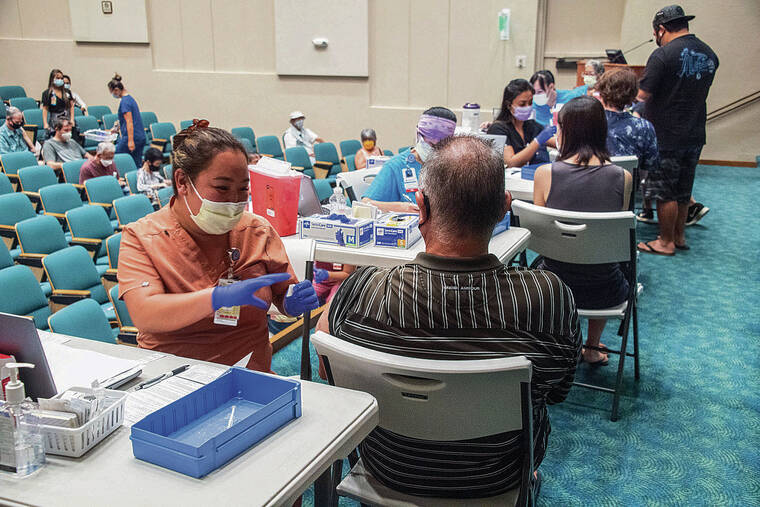
Mahalo for supporting Honolulu Star-Advertiser. Enjoy this free story!
The Hawaii Department of Health says COVID-19 reinfections have risen to account for about 10% of new confirmed cases in the state.
DOH decided Wednesday to include reinfections in its tally of coronavirus cases, lending a big boost to this week’s tally of new cases — 12,755 — which is elevenfold of what was reported the previous week. The count includes 10,995 reinfection cases dating back to September 2020, when the first repeat case of COVID-19 in the state was recorded.
The reinfections pushed Hawaii’s total COVID-19 case count since the start of the pandemic to 355,959.
Health officials said that going forward, reinfections will be included on its COVID-19 data dashboard to reflect the affects of more recent variants in the pandemic.
“As we’ve been looking at it and seeing that the trends are changing recently, we felt it was more urgent to make sure we get this information out now,” said State Epidemiologist Dr. Sarah Kemble during a virtual news conference Wednesday. “We have been working on it for some time, but we were able to put this together and wanted to get this out, as we’re seeing this notable change in trends with BA.5.”
Before Wednesday, the case count represented the number of unique individuals whose positive tests were reported, so a person who tested positive multiple times was counted only once.
Now, reinfections will be counted as long as the second case happened at least 90 days after the first. But even the reinfection count is likely an undercount, DOH said, given the increased use of home test kits.
Health officials say the rise in reinfections is all the more reason why people should remain up to date on their vaccines and get the bivalent boosters when eligible.
“No. 1, you can’t assume just because you’ve had COVID-19 before that you aren’t going to get it again,” Kemble said. “The numbers are clearly showing that you can. What can you do to protect yourself? Vaccine is a good way to protect yourself from infection and, in particular, severe disease and death.”
The data underscores that limited immunity from previous infection lasts only so long, Kemble said. The bivalent boosters target the specific omicron subvariant BA.5, which is the dominant one in circulation right now.
According to the latest variant report published Tuesday, BA.5 makes up 92% of COVID-19 variants circulating in the state, while BA.4 makes up 4% and BA.4.6 makes up 3%.
The remaining 1% belongs to BA.2.75, an offshoot of BA.2 that some have nicknamed “Centaurus.”
As of Wednesday, 77.6% of the state’s population had completed their primary series of COVID-19 vaccinations, with 45.3% having received a first booster, according to DOH.
A total of 54,892 bivalent boosters have been administered in the state since they became available over the Labor Day weekend.
The new bivalent boosters are available to anyone ages 12 and older if it has been at least two months since the last shot of the primary series. Those seeking a specific type of vaccine or booster can conduct a search at vaccines.gov to find a nearby pharmacy, health center or hospital offering them.
Kemble said reinfections were rare early in the pandemic, so reinfection statistics were relatively insignificant. However, the percentage of COVID-19 cases involving people who have had prior infection has increased over time.
The number of reinfections showed a marked rise above 5% of recently reported cases in June, when BA.2 was dominant, and rose further over ensuing months as BA.5 became dominant.
DOH does not have data on the vaccination or booster status, nor outcomes, of the reinfection cases.
The seven-day average of new cases reported Wednesday was 164, representing a bump up due to the reinfections added in, compared with 148 reported Sept. 21.
Kemble said the epidemic curve shows the daily average of COVID-19 cases in Hawaii is currently at a plateau.
“We are relatively flat right now,” she said. “So we’ve been coming down off of a downtrend and we’re kind of at a relatively flat spot right now.”
DOH says reinfections will be counted in the seven-day average going forward, resulting in higher counts than under the previous data reporting method, but that epi curve trends should remain consistent across time.
DOH also said the 12,755 count on Wednesday includes about 800 historical cases added as data was cleaned up.
The positivity rate continued to fall, to 5.7% compared with 6.0% reported the previous week. Hospitalizations also trended down, with a weekly average of 64 COVID-19 patients per day reported Wednesday, down from 67 the previous week.
Seven more deaths were reported over the week, bringing Hawaii’s COVID-related death toll to 1,686 since the start of the pandemic.
When asked, Kemble said she does not believe the pandemic is over.
“I think vaccine is a major factor in allowing us to return to more normal routines, and yet we’re still having hundreds of deaths a day from COVID-19 nationwide, and that, to me, is still a major impact,” she said. “We’re still seeing a lot of human and economic impact from COVID-19 so I would not call the pandemic over.”
Read More: World News | Entertainment News | Celeb News
Star Ads





